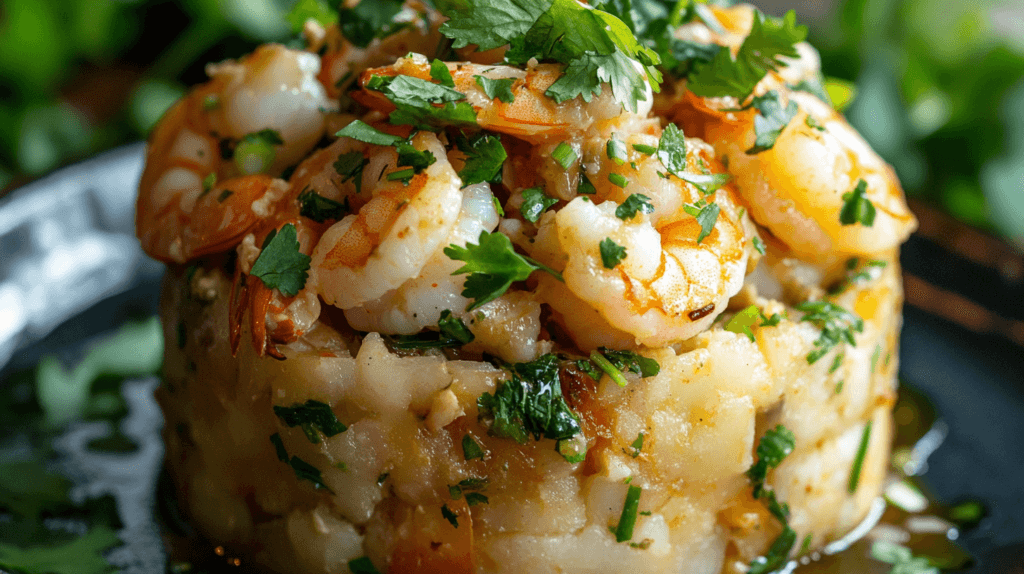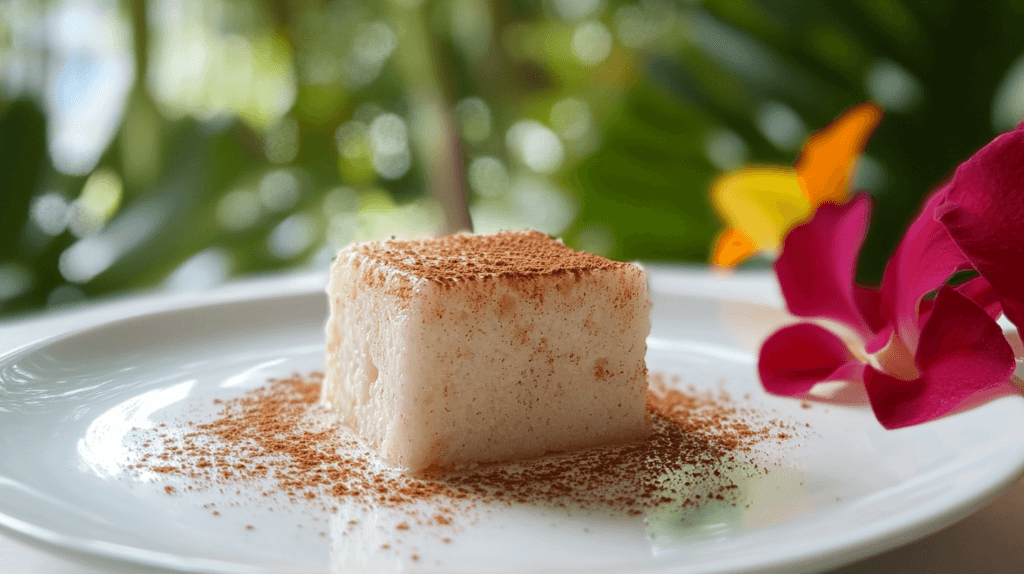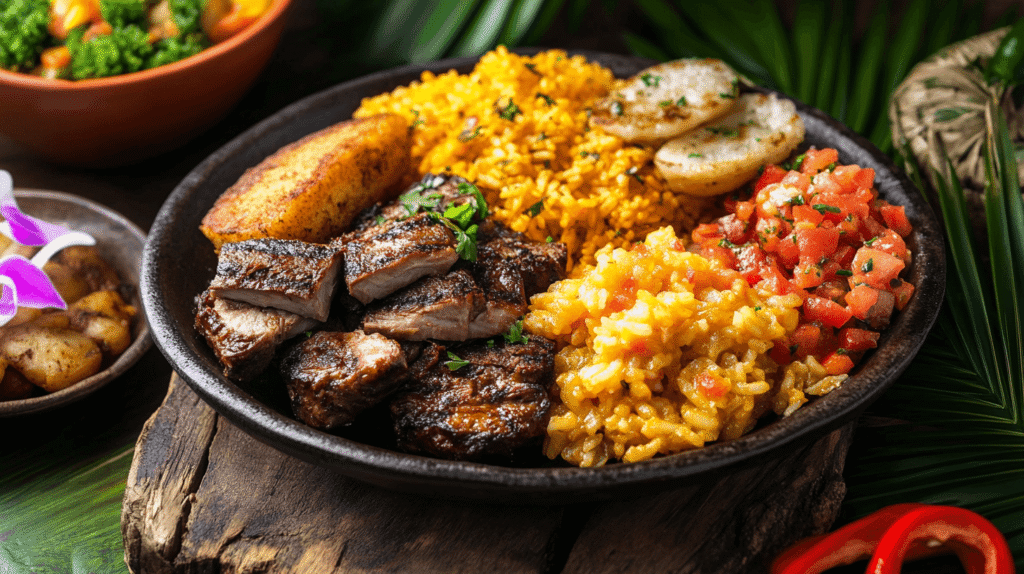Puerto Rican cuisine is a delicious fusion of cultures, traditions, and ingredients that reflect the island’s vibrant history. Influenced by Spanish, African, and Taíno (indigenous) culinary techniques, Puerto Rican recipes are a celebration of flavor, texture, and color. These dishes showcase the island’s tropical abundance, with ingredients like plantains, coconuts, rice, and aromatic spices playing starring roles.
But what makes Puerto Rican food so irresistible? It’s the way these ingredients are combined with love, creativity, and bold spices like sofrito, sazón, and adobo, creating a symphony of flavors that satisfy the soul. Whether it’s a savory dish like Arroz con Gandules, a festive dessert like Flan de Queso, or a refreshing glass of Coquito, Puerto Rican recipes promise to bring joy to your kitchen and your taste buds.
In this article, we’ll explore a wide range of Puerto Rican recipes, from hearty meals and street food snacks to decadent desserts and holiday specialties. By the end, you’ll feel inspired to whip up these traditional dishes and bring a slice of Puerto Rico into your home.
Table of Contents
Signature Puerto Rican Dishes

Puerto Rico’s culinary landscape is full of iconic dishes that are loved both on the island and around the world. These dishes represent the heart and soul of Puerto Rican cuisine, blending simple ingredients with bold flavors. Let’s take a closer look at some of the must-try staples.
Arroz con Gandules (Rice with Pigeon Peas)
Ingredients Needed for Arroz con Gandules
Arroz con Gandules is the ultimate comfort food in Puerto Rico. To make this dish, you’ll need:
- Long-grain white rice
- Gandules (pigeon peas)
- Sofrito (a blend of onions, peppers, garlic, and herbs)
- Tomato sauce
- Sazón and adobo (essential Puerto Rican spices)
- Pork or ham for added flavor
- Olive oil and vegetable broth
Step-by-Step Preparation
- Start with Sofrito: Heat olive oil in a large pot and sauté sofrito until it becomes aromatic.
- Add the Base Ingredients: Stir in tomato sauce, sazón, adobo, and chopped pork or ham. Let it all cook together for a few minutes to develop flavor.
- Incorporate Rice and Gandules: Add the rice and pigeon peas to the pot and mix everything well. Pour in vegetable broth to cover the rice.
- Simmer and Cook: Cover the pot and let it simmer on low heat until the rice is fully cooked and fluffy.
- Fluff and Serve: Fluff the rice with a fork before serving.
Tips for Perfecting the Dish
- For a smoky twist, use smoked pork or bacon.
- Ensure you don’t stir the rice while it cooks to avoid it becoming mushy.
- Pair it with a slice of avocado or fried plantains for the ultimate Puerto Rican experience.
Mofongo
The Cultural Significance of Mofongo
Mofongo is more than just a dish; it’s a symbol of Puerto Rican pride. This hearty creation is made from mashed green plantains, garlic, and crispy pork cracklings. With African and Taíno roots, it represents the blending of cultures on the island.
Variations of Mofongo
Mofongo can be enjoyed in countless ways:
- Traditional Mofongo: Served as a side dish with garlic sauce.
- Stuffed Mofongo: Filled with shrimp, chicken, or vegetables.
- Seafood Mofongo: Topped with lobster, crab, or calamari in a creamy sauce.
Detailed Recipe to Make Authentic Mofongo
- Prepare the Plantains: Peel green plantains and slice them into thick rounds. Fry them in oil until golden.
- Mash the Ingredients: In a large mortar and pestle, mash the fried plantains with garlic, olive oil, and pork cracklings. Season with salt.
- Shape and Serve: Form the mashed mixture into small mounds or bowls. Serve with broth or your choice of meat or seafood.
Pro Tip
For a healthier version, you can bake the plantains instead of frying them.
Lechón Asado (Roast Pork)
Importance of Lechón in Celebrations
Lechón Asado is a star at Puerto Rican parties and festivals, especially during Christmas and New Year. A whole pig is marinated and roasted to perfection, creating tender, juicy meat with a crispy skin known as cuerito.
How to Prepare Traditional Lechón Asado
- Marinate the Pork: Prepare a marinade with garlic, oregano, olive oil, vinegar, and sazón. Rub it generously over a pork shoulder or whole pig. Let it marinate overnight.
- Slow Roast: Roast the pork at low heat for several hours, basting occasionally to keep it moist.
- Crisp the Skin: Increase the oven temperature near the end to crisp up the skin.
- Serve: Slice and serve with Arroz con Gandules and Tostones for a complete Puerto Rican feast.
Traditional Puerto Rican Soups
Puerto Rican soups are a warm and comforting way to experience the flavors of the island. These dishes are hearty, flavorful, and often served as a main course. Two standout examples are Asopao de Pollo and Sancocho, both of which are packed with layers of taste and tradition.
Asopao de Pollo (Chicken and Rice Soup)
Ingredients and Preparation
Asopao de Pollo is the ultimate Puerto Rican comfort food. Think of it as a cross between soup and stew, with rice as the star ingredient. Here’s what you’ll need:
- Chicken thighs or drumsticks
- Long-grain white rice
- Sofrito (a Puerto Rican cooking staple)
- Tomato sauce
- Chicken broth
- Bell peppers, onions, and garlic
- Adobo and sazón for seasoning
- Green olives and capers for added depth of flavor
Preparation Steps:
- Sauté the Chicken: Season the chicken with adobo and brown it in a large pot. Remove and set aside.
- Build the Base: In the same pot, sauté sofrito, tomato sauce, and vegetables until fragrant.
- Simmer with Broth: Add the chicken back to the pot, pour in chicken broth, and let it simmer.
- Add Rice: Stir in the rice and cook until it absorbs the flavors. Adjust the consistency by adding more broth if needed.
- Garnish and Serve: Finish with green olives and fresh cilantro. Serve hot.
The Perfect Occasions to Serve Asopao de Pollo
This dish is ideal for cold weather, family gatherings, or when you need a comforting one-pot meal. It’s especially popular during the holidays when large pots are shared with loved ones.
Sancocho
Unique Flavors of Sancocho
Sancocho is a rich stew that showcases Puerto Rican roots. It’s made with a variety of meats, starchy vegetables, and aromatic spices. This dish is a celebration of Puerto Rico’s agricultural bounty.
Instructions to Make Sancocho Step-by-Step
- Choose Your Meats: Use a mix of beef, pork, chicken, or even goat. Cut them into chunks and season with adobo.
- Sauté the Meats: In a large pot, brown the meat in olive oil for a flavorful base.
- Add Vegetables: Include root vegetables like yucca, plantains, taro, and sweet potatoes. Add corn on the cob for extra sweetness.
- Simmer the Stew: Pour in beef or chicken broth, then add sofrito, tomato sauce, and sazón. Let it simmer for 2-3 hours until the meat is tender.
- Season and Serve: Adjust the seasoning with salt and pepper. Serve with a side of white rice or avocado slices.
Pro Tip for Sancocho
To deepen the flavor, cook the stew a day in advance and reheat it before serving. The flavors will meld together beautifully overnight.
Classic Puerto Rican Appetizers
Puerto Rican appetizers are the perfect introduction to the island’s flavors. These small bites pack a punch, often fried to crispy perfection and seasoned with Puerto Rico’s iconic spice blends. Here are two favorites: Alcapurrias and Bacalaitos.
Alcapurrias
What Are Alcapurrias?
Alcapurrias are savory fritters made from a dough of mashed green plantains and yautía (a starchy root vegetable). The dough is stuffed with a flavorful meat filling, typically ground beef or crab, and then deep-fried until golden brown. They are a popular street food and a staple at family gatherings.
Ingredients and Cooking Method
To make Alcapurrias, you’ll need:
- For the dough: Green plantains, yautía, olive oil, and salt.
- For the filling: Ground beef or crab, sofrito, tomato sauce, sazón, and olives.
Cooking Steps:
- Prepare the Dough: Peel and grate the green plantains and yautía. Mix them into a smooth dough with a pinch of salt and a drizzle of olive oil.
- Make the Filling: Cook ground beef or crab in a skillet with sofrito, tomato sauce, sazón, and olives until fully cooked and flavorful.
- Assemble the Fritters: Take a portion of the dough, flatten it in your hand, and place a spoonful of filling in the center. Carefully seal the dough around the filling to form a torpedo shape.
- Fry to Perfection: Heat oil in a deep pan and fry the Alcapurrias until golden brown. Drain on paper towels and serve hot.
Pro Tip
For extra flavor, let the dough rest in the fridge for an hour before assembling the fritters. This helps the plantain mixture firm up and absorb more flavor.
Bacalaitos (Codfish Fritters)
Recipe and Serving Ideas for Bacalaitos
Bacalaitos are thin, crispy fritters made from salted codfish. They’re light, golden, and irresistibly crunchy, often served as a snack or appetizer.
Ingredients Needed:
- Salted codfish (bacalao)
- All-purpose flour
- Baking powder
- Garlic, sofrito, and fresh herbs
- Water or fish stock for the batter
- Oil for frying
Cooking Steps:
- Prepare the Codfish: Soak the salted codfish in water overnight to remove excess salt. Boil it until tender, then shred it into small pieces.
- Make the Batter: In a bowl, mix flour, baking powder, shredded codfish, sofrito, garlic, and herbs. Gradually add water or fish stock until you get a smooth, pourable batter.
- Fry the Fritters: Heat oil in a skillet. Spoon the batter into the hot oil and fry until golden and crispy on both sides.
- Serve: Bacalaitos are best served immediately, with a squeeze of lime for extra zest.
Tips for Perfect Bacalaitos
- Ensure the batter isn’t too thick, as a thinner consistency creates lighter, crispier fritters.
- For added texture, try including finely chopped bell peppers or onions in the batter.
Puerto Rican Desserts

Puerto Rican desserts are a sweet and satisfying way to end a meal. They are rich, creamy, and infused with tropical flavors like coconut and caramel. Let’s explore two beloved Puerto Rican desserts: Tembleque and Flan de Queso.
Tembleque (Coconut Pudding)
Ingredients and Preparation Method
Tembleque is a creamy coconut pudding with a silky texture. Its name, which means “wobbly” in Spanish, describes the way it jiggles on the plate. Here’s what you’ll need to make it:
- Coconut milk
- Sugar
- Cornstarch
- A pinch of salt
- Ground cinnamon for garnish
Steps to Prepare Tembleque:
- Mix the Ingredients: In a saucepan, whisk together coconut milk, sugar, cornstarch, and a pinch of salt until smooth.
- Cook the Mixture: Heat the mixture over medium heat, stirring constantly, until it thickens to a pudding-like consistency.
- Set and Chill: Pour the mixture into molds or small bowls. Let it cool to room temperature before chilling in the refrigerator for at least 4 hours.
- Garnish and Serve: Sprinkle ground cinnamon on top before serving.
How to Get the Best Texture for Tembleque
- Strain the mixture before cooking to ensure a smooth, lump-free texture.
- Use full-fat coconut milk for a creamier result.
Flan de Queso (Cheese Flan)
Why Flan de Queso is a Dessert Staple
Flan de Queso is a decadent Puerto Rican twist on traditional flan, made even richer with the addition of cream cheese. Its creamy texture and caramel topping make it a dessert that’s hard to resist.
Step-by-Step Recipe
- Prepare the Caramel: In a saucepan, melt sugar over medium heat until it becomes a golden caramel. Pour the caramel into the bottom of a baking dish, swirling to coat the base evenly.
- Make the Flan Mixture: In a blender, combine cream cheese, sweetened condensed milk, evaporated milk, eggs, vanilla extract, and a pinch of salt. Blend until smooth.
- Pour and Bake: Pour the mixture over the caramel in the baking dish. Place the dish in a larger pan filled with water (a water bath) and bake at 350°F (175°C) for about an hour, or until set.
- Cool and Unmold: Let the flan cool, then refrigerate for at least 4 hours. To serve, invert the flan onto a plate so the caramel drizzles over the top.
Tips for Perfect Flan
- Bake the flan in a water bath to ensure even cooking and prevent cracks.
- Use room-temperature cream cheese for a smoother consistency.
Frequently Asked Questions About Puerto Rican Recipes
1. What is the most iconic Puerto Rican dish?
The most iconic Puerto Rican dish is Arroz con Gandules, often referred to as the national dish of Puerto Rico. This flavorful combination of rice, pigeon peas, and seasoned meat is typically served during holidays and celebrations. For a festive touch, learn how to complement this dish with sides like those featured in What to Serve with Rotisserie Chicken.
2. How is Puerto Rican Sofrito different from other types?
Puerto Rican sofrito is unique due to its blend of sweet peppers called ají dulce, cilantro, culantro (a stronger version of cilantro), onions, garlic, and sometimes tomatoes. This aromatic blend forms the base of most Puerto Rican dishes. For similar bases, you can explore tips on making Dutch Oven Soups.
3. Can I make Puerto Rican recipes with substitutes for tropical ingredients?
Yes! If you can’t find ingredients like green plantains or yautía, you can substitute them with green bananas or even potatoes in certain recipes. Similarly, canned coconut milk works well for desserts and drinks.
4. What are the key spices in Puerto Rican cooking?
The key spices in Puerto Rican cooking are adobo (a blend of garlic, oregano, salt, and pepper) and sazón (a seasoning mix with coriander, annatto, and other spices). Sofrito is also essential for flavor. You might also enjoy experimenting with other spice blends as described in Seafood Boil Sauce Recipe.
5. Are Puerto Rican dishes typically spicy?
Puerto Rican food is not usually spicy but is highly flavorful. Instead of heat, the cuisine focuses on rich, savory, and aromatic seasonings. However, you can add hot sauce or peppers if you prefer spicier dishes. For spice lovers, Seafood Boil Sauce offers some inspiration.
6. Can Puerto Rican recipes be made vegetarian or vegan?
Absolutely! Many Puerto Rican dishes, such as Tostones, Mofongo, and Yuca al Mojo, are naturally vegetarian or vegan. Others, like Arroz con Habichuelas (Rice and Beans), can easily be adapted by omitting meat or using plant-based alternatives.
Conclusion
Puerto Rican cuisine is a celebration of flavor, culture, and tradition. From hearty meals like Arroz con Gandules and Lechón Asado to sweet treats like Tembleque and festive drinks like Coquito, every dish tells a story of the island’s rich heritage. The blend of Spanish, African, and Taíno influences makes Puerto Rican recipes uniquely delicious and universally appealing.
Whether you’re looking to try a new dish, celebrate a holiday, or simply explore a new cuisine, Puerto Rican recipes bring vibrant, comforting flavors to your table. So grab your ingredients, dive into the kitchen, and bring a little piece of Puerto Rico to your home. ¡Buen provecho!
Printable Recipe Card
Want just the essential recipe details without scrolling through the article? Get our printable recipe card with just the ingredients and instructions.

